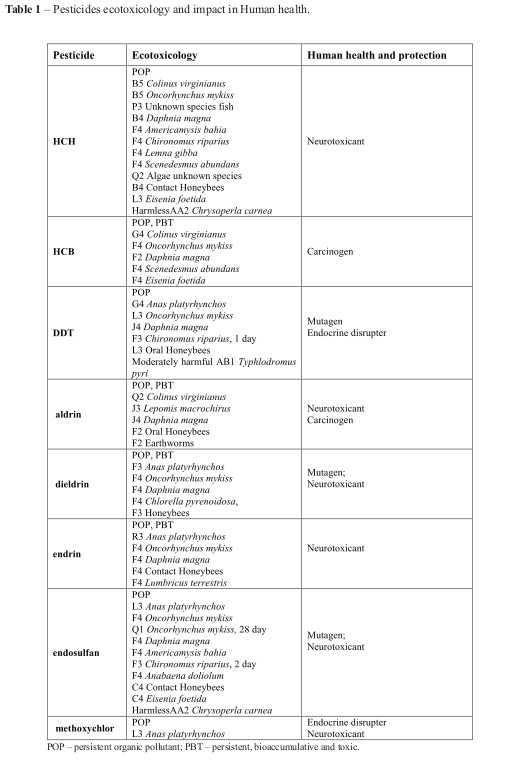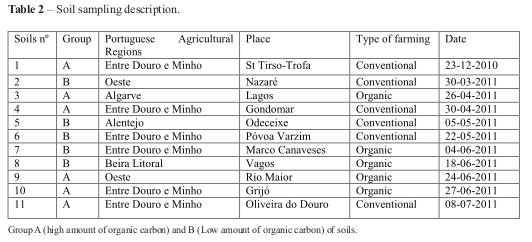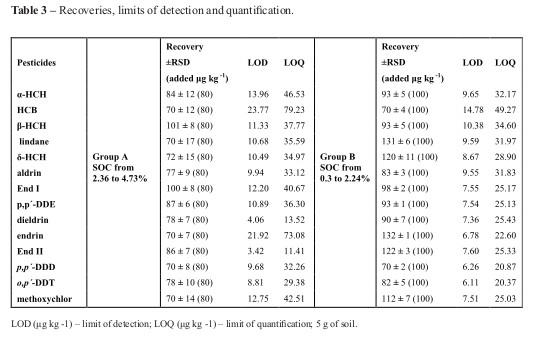Services on Demand
Journal
Article
Indicators
-
 Cited by SciELO
Cited by SciELO -
 Access statistics
Access statistics
Related links
-
 Similars in
SciELO
Similars in
SciELO
Share
Revista de Ciências Agrárias
Print version ISSN 0871-018X
Rev. de Ciências Agrárias vol.35 no.2 Lisboa July 2012
Determination of organochlorine pesticides in agricultural soils applyng Quechers, C-ECD and GC-MS/MS
Determinação de pesticidas organoclorados em solos agrícolas utilizando a metodologia Quechers, GC-ECD e GC-MS/MS
Luísa Correia Sá[1],[2], Virgínia Cruz Fernandes[1],[3], Conceição Calhau[2], Valentina Fernandes Domingues[1] and Cristina Delerue Matos[1]
[1] REQUIMTE, ISEP - Rua Dr. António Bernardino de Almeida nº431, 4200-072 Porto. E-mail: vfd@isep.ipp.pt
[2] FCNAUP - Rua Dr. Roberto Frias 4200-465 Porto, Portugal. E-mail: mariasrcs@iol.pt
[3] CIQ (Investigation Centre) - Rua do Campo Alegre nº 687, 4169-007, Porto, Portugal.
ABSTRACT
The organochlorine pesticides (OCPs), due the wide use in agriculture until about 30 years (except the most recent bans by the EU for lindane, methoxychlor and endosulfan) and their chemical stability and slow biodegradation became ubiquitous pollutants. Most OCPs are persistent organic pollutants that have long life cycles in the environment and being transported for long distances. The residues of pesticides in soil can be absorbed by plants, entering the food chain, leading to bioaccumulation. The objective of this study was to determine the presence of 14 OCPs (HCH (α, β, ζ), HCB, lindane, aldrin, α-endosulfan, dieldrin, p, p'-DDE, endrin, endosulfan β-p-p' -DDD, o-p'-DDT and methoxychlor) in soils of 5 Portuguese regions. The extraction was performed with QuEChERS, analysis by GC-ECD and confirmation by GC-MS/MS. One sample showed a residue above the LOQ, revealing contamination by dieldrin at a concentration of 45.36 µg .kg-1.
Keywords: Gas chromatography, organochlorine pesticide, QuEChERS, soil.
RESUMO
Os pesticidas organoclorados (OCPs), devido à sua ampla utilização na agricultura até há cerca de 30 anos (exceto as mais recentes proibições, pela UE, de lindano, de metoxicloro e de endossulfão) à sua estabilidade química e à lenta biodegradação tornaram-se poluentes omnipresentes. A maioria dos OCPs são poluentes orgânicos persistentes que se caracterizam por longos ciclos de vida no ambiente e por serem transportados a longas distâncias. Os resíduos dos pesticidas nos solos podem ser adsorvidos pelas plantas, entrando na cadeia alimentar, levando à sua bioacumulação. O objetivo deste estudo foi determinar a presença de 14 OCPs (HCH (α, β, ζ), HCB, lindano, aldrina, α-endossulfão, dieldrina, p-p'-DDE, endrina, β-endossulfão p-p'-DDD, o-p'-DDT e metoxicloro). em solos agrícolas de 5 Regiões Portuguesas. A extração foi realizada com QuEChERS, as análises por GC-ECD e a confirmação por GC-MS/MS. Foi apenas encontrado um resíduo acima do LOQ, evidenciando contaminação por dieldrina na concentração de 45.36 µg kg-1.
Palavras-chave: Cromatografia gasosa, pesticida organoclorado, QuEChERS, solo.
INTRODUCTION
Organochlorine pesticides (OCP) are one of the most prevalent contaminants (Negoita, Covaci, Gheorghe et al. 2003) and were applied in the second half of the twentieth century worldwide as insecticides and fungicides against pests in fruit growing, horticultural and arable crops (Hilber, Mader, Schulin et al. 2008).
Although the human health effects after exposure to OCPs are not adequately understood it has been considered that these contaminants have an endocrine-disrupting activity and that they have also been implicated in the etiology of various diseases and endocrine-related disorders, such as pancreatic cancer, breast cancer, non-Hodgkins lymphoma, leukemia, uterine cancer, liver cancer, sexual precocity, cryptorchidism, and low sperm concentration (Botella, Crespo, Rivas et al. 2004).
In Portugal, according with the legislation (Decreto-Lei nº347/88 and Portaria nº660/88) most of the OCPs were prohibited in 80s (Cruz, Lino and Silveira 2003) but they can be found in the environment even decades after being banned (Negoita, Covaci, Gheorghe et al. 2003).
In the last decades the application of pesticides has become an essential matter for discussion (Asensio-Ramos, Hernandez-Borges, Ravelo-Perez et al. 2010). Soil is considered to be an important agricultural resource which has an ability to retain agro-chemicals including pesticides (Rashid, Nawaz, Barker et al. 2010). It is known that OCPs still persist in soils (Zhang, Luo, Zhao et al. 2006) because they are not degraded, nor volatilized, nor even leached due to their lipophilicity (Connell, Miller, Mortimer et al. 1999; Shen and Wania 2005) and strong affinity to soil organic matter (SOM) (Ahmad, Nelson and Kookana 2006). Nevertheless sorption of organic pollutants to SOM and other soil particles (Prosen, Fingler, Zupancic-Kralj et al. 2007) could not prevent specific plants of taking them up (Hilber, Mader, Schulin et al. 2008)
Consequently is has led to the ingress of OCPs into growing plants and the persistence of their residues (Waliszewski, Carvajal, Gomez-Arroyo et al. 2008).Which by its turn affects animals due to the entrance of such pollutants in food chains.
Determination of OCPs is therefore of relevant importance and it is fundamental that the methodology for determining residues guarantees true and precise results at appropriately low limits of detection (Wiilkowska and Biziuk 2011).
Recent studies have applied ultrasonic solvent extraction (Tor, Aydin and Ozcan 2006), pressurized liquid extraction (Vega Moreno, Sosa Ferrera, Santana Rodriguez et al. 2008), shake-?ask extraction (Dabrowska, Dabrowski, Biziuk et al. 2003), microwave assisted micellar extraction (Vega Moreno, Sosa Ferrera and Santana Rodiguez 2006) lowed in some cases by a clean-up step with solid-phase extraction (SPE) (Dabrowska, Dabrowski, Biziuk et al. 2003) or solid-phase microextraction (SPME) (Vega Moreno, Sosa Ferrera and Santana Rodiguez 2006).
The QuEChERS methodology has also been recently applied for the determination of pesticides in soils (Asensio-Ramos, Hernandez-Borges, Ravelo-Perez et al. 2010; Rashid, Nawaz, Barker et al. 2010). Anastassiades et al. introduced this methodology in 2003 as an original analytical method which combined the extraction/isolation of pesticides from food matrices and extract clean-up (Wiilkowska and Biziuk 2011). Although it started to be applied to food matrices nowadays the application of the method to other matrices and also to other analytes has occurred (Wiilkowska and Biziuk 2011).
In the determination of OCPs gas chromatography coupled to an electron-capture detector has been considered highly sensitive for the quantification of these compounds (Fenik J. 2011; Fernandes, Domingues, Mateus et al. 2011).
The aim of this work was the determination of 14 organochlorine pesticides residues in agricultural soils from 5 Portuguese Agricultural Regions, applying the QuEChERS methodology and the GC-ECD.
MATERIAL AND METHODS
Reagents and materials
For this study 14 OCPs (Table 1) were used: α, β, γ and ζ hexachlorocyclohexanes (HCH), hexachlorobenzene (HCB), o,p-DDT ([1,1,1 trichloro-2,2-bis- (p-chlorophenyl) ethane]), p,p-DDE ([2,2-bis(p-chlorophenyl)-1,1-dichloroethylene]), p,p-DDD (dichlorodiphenyldichloro-ethane), aldrin, dieldrin, endrin,α, β endosulfan, and methoxychlor. Pesticide standards (purity > 97.0%) were obtained from Chemservice (West Chester, PA, USA), Dr. Ehrenstorfer GmbH (Augsburg, Germany) and Sigma-Aldrich Co. A mixed stock solution of 350 µg L-1, containing all of the OCPs, was prepared in n-hexane.

The internal standard (IS) of 4.4 – dichlorobenzophenone was purchased from Sigma-Aldrich and was 7400 µg.L-1. All solutions were prepared in n-hexane. The n-hexane and the acetonitrile used were of HPLC grade from Merck.
The selected QuEChERS (EUMIV50CT-VP) and cleanup (CUMPS15C18CT) were obtained from UCT (Bristol, PA).
Sampling
The samples were collected between December 2010 and July 2011 from 5 Portuguese Agricultural Regions, according to the Atlas from the Portuguese Geographic Institute (IGEO) (IGEO). All the soils were from conventional or organic farms (more than 5 years of organic practices), collected from 10-20 cm deep in the ground and placed directly in a suitable plastic bag (1 kg). Before use, soil samples were air-dried at room temperature and then sifted. Soils were divided in two groups. (Table 2)

Soil organic carbon (SOC)
For determining SOC in soils it was used a dry oxidative combustion method, Shimadzu-make TOC analyser (model VCSN, Shimadzu®, Japan) with a solid sample module (SSM-5000A).
Extraction procedure and method validation
The soil samples were extracted according to a previously described method (Correia-Sá L. , Fernandes V. C., Carvalho M. et al. 2012 in press). The method was validated according to the SOC (Correia-Sá L. , Fernandes V. C., Carvalho M. et al. 2012 in press). Five grams of soil were hydrated by adding 3 mL of water and after 7 mL of acetonitrile. The tubes were capped tightly and shaken in vortex. Then it was added 6 g magnesium sulphate (MgSO4), 1.5 g sodium chloride (NaCl), 0.750 g disodium citrate sesquihydrate (Na2HCit 1.5H2O), 1.5 g sodium citrate dihydrate (Na3Cit 2H2O), from UCT® and it were shaken by a vortex. After the mixture was sonicated for 1 min. Samples were then centrifuged at 5,000 rpm for 10 min. A 1.5 mL of the supernatant was removed and transferred to the clean-up tube containing 50 mg of primary secondary amine (PSA), 150 mg of MgSO4 and 50 mg of C18, CUMPS15C18CT from UCT® (Bristol, PA). The tubes were capped tightly and shaken by vortex for 1 min followed by centrifugation at 4,500 rpm for 5 min. An aliquot of the supernatant (1 mL) was transferred to a vial, and the extract was concentrated just to dryness using a gentle stream of nitrogen. Residue was reconstituted in 1.0 mL of n-hexane. Finally, the sample was capped, vortexed and placed into an autosampler vial for GC analysis (Correia-Sá L. , Fernandes V. C., Carvalho M. et al. 2012 in press).
Gas Chromatography – Electron Capture Detector
OCP were analysed using a Shimadzu GC-2010 with an ECD apparatus, equipped with a capillary column of 30 m, ZB-XLB (0.25 mm i.d., 0.25 µm film thickness, Zebron- Phenomenex). The oven temperature was programmed starting at 65ºC and held for 2 min, followed by increases of 8ºC/min to 160ºC, then 2ºC/min to 235ºC, and then 15ºC/min to 250ºC. The injection port was at 250ºC splitless mode, and the detection was carried out at 300ºC. Helium (Linde Sogás) was used as carrier gas at constant flow rate of 1.3 mL/min, whereas nitrogen (Linde Sogás, purity=99.999%) was employed as makeup gas at flow of 30 mL/min. The system was operated by GC Solution Shimadzu software.
Gas Chromatography - Mass Spectrometry (GC-MS/MS).
In addition, the real samples with positive results by GC-ECD were analyzed using a Thermo Trace-Ultra gas chromatograph coupled to an ion trap mass detector Thermo Polaris, operated in the electron impact ionization (EI) at 70 eV. The ion source temperature was 250 C and the MS transfer temperature, 250 C. The system was operated by Xcalibur v 1.3 software. Confirmation of residues was carried out by GC-MS/SIM and MS/MS using a Supelco column fitted with an SLB-5MS (30 m 0.25 mm, 0.25 µm film thickness) column operating in the splitless mode; helium was used as carrier gas at a constant flow rate of 1.3 mL/min. The injector was maintained at 240 C. The oven temperature was programmed starting at 40 C and held for 2 min, followed by increases of 30 C/min to 220 C, held for 5 min, then 10 C/min to 270 C, and held for 1 min. For the identification of pesticides, the retention time, and three ions, the NIST and Wiley pesticide libraries were used. The MS/MS conditions were fixed for each compound, trying to select as precursor ion the one with the highest m/z ratio and abundance.
RESULTS AND DISCUSSION
The method yield good recoveries for both groups of soils and acceptable limits of quantification (Table 3) (Correia-Sá L. , Fernandes V. C., Carvalho M. et al. 2012 in press).

Positive findings were found in soils for HCH isomers and dieldrin. The residues were found in samples produced by organic farming as well as in conventional farming. Only in one sample, from Entre Douro e Minho Region, was detected a residue above the LOQ, with a concentration of 45.36 µg.kg-1 for dieldrin. This can constitute a threat to the human consumer. The other studied pesticides were not detected in the samples.
The results obtained with this study reveal the importance of monitoring on a regular basis the levels of OCPs.
In Portugal, at the present moment, there are no limits establish for OCPs in soil. In Swiss legislation there is a guide value of 2 mg kg-1, but this value refers to the sum of aldrin, dieldrin, endrin or DDT isomers and its degradation products (Hilber, Mader, Schulin et al. 2008). So a potential health risk for humans is indicate by this trigger value, according to the Swiss legislation (Hilber, Mader, Schulin et al. 2008). None of the sampled soils exceeds this value.
The contamination seems to be independent of the farming system as the percentage of positives samples is similar in conventional and organic farming.
CONCLUSIONS
The results obtained showed that some of these 14 compounds OCP tend to be very persistent, as they are still found although they were banned decades ago. Positive findings were found for HCH isomers and dieldrin.
From the 11 Portuguese soils studied only one soil sample obtained a concentration of dieldrin higher than the LOQ
BIBLIOGRAPHICAL REFERENCES
Ahmad, R.; Nelson, P.N.and R.S. Kookana (2006) - The molecular composition of soil organic matter as determined by 13C NMR and elemental analyses and correlation with pesticide sorption. European Journal of Soil Science, 57,6: 883-893. [ Links ]
Asensio-Ramos; Hernandez-Borges, M.J.;Ravelo-Perez, L.M. and Rodriguez-Delgado, M.A. (2010) - Evaluation of a modified QuEChERS method for the extraction of pesticides from agricultural, ornamental and forestal soils. Analytical and Bioanalytical Chemistry, 396,6: 2307-2319. [ Links ]
Botella, B.; Crespo J.; Rivas, A.; Cerrillo, I.; Olea-Serrano, M.F. and Olea, N. (2004) - Exposure of women to organochlorine pesticides in Southern Spain. Environmental Research, 96,1: 34-40. [ Links ]
Connell, D.W.; Miller, G.J.; Mortimer, M.R.; Shaw, G.R. and Anderson, S.M. (1999) - Persistent lipophilic contaminants and other chemical residues in the Southern Hemisphere. Critical Reviews in Environmental Science and Technology, 29,1: 47-82. [ Links ]
Correia Sá, L.; Fernandes, V.C.; Carvalho, M.; Calhau, C.; Domingues, V.F. and D.-M.C. (2012) - Optimization of QuEChERS method for the analysis of organochlorine pesticides in soils with diverse organic matter. Journal of Separation Science, (in press). [ Links ]
Cruz, S.; Lino, C. and Silveira, M.I. (2003) - Evaluation of organochlorine pesticide residues in human serum from an urban and two rural populations in Portugal. Science of the Total Environment, 317,1-3: 23-35. [ Links ]
Dabrowska, H.; Dabrowski, L.; Biziuk, M.; Gaca, J. and Namiesnik, J. (2003) - Solid-phase extraction clean-up of soil and sediment extracts for the determination of various types of pollutants in a single run. Journal of Chromatography A, 1003,1-2: 29-42. [ Links ]
Fenik J. T. M. A. B. M. (2011). Properties and determination of pesticides in fruits and vegetables. Trac-Trends in Analytical Chemistry. [ Links ]
Fernandes, V. C.; Domingues, V. F.; Mateus N.and Delerue Matos C. (2011). Organochlorine Pesticide Residues in Strawberries from Integrated Pest Management and Organic Farming. Journal of Agricultural and Food Chemistry, 59,14 7582-7591. [ Links ]
Hilber, I.; Mader, P.; Schulin, R and Wyss, G. S. (2008). Survey of organochlorine pesticides in horticultural soils and there grown Cucurbitaceae. Chemosphere, 73,6: 954-961. [ Links ]
IGEO (2011) - Retrieved 20-10-2011, from http://www.igeo.pt/atlas/Cap3/Cap3b_p138_image.html. [ Links ]
Negoita, T. G.; Covaci, A.; Gheorghe, A. and Schepens, P. (2003) - Distribution of polychlorinated biphenyls (PCBs) and organochlorine pesticides in soils from the East Antarctic coast. Journal of Environmental Monitoring, 5,2: 281-286. [ Links ]
Prosen, H.; Fingler, S.; Zupancic Kralj L. and Drevenkar, V. (2007) - Partitioning of selected environmental pollutants into organic matter as determined by solid-phase microextraction. Chemosphere, 66,8: 1580-1589. [ Links ]
Rashid, A.; Nawaz, S.; Barker, H.; Ahmad, I. and Ashraf, M. (2010). Development of a simple extraction and clean-up procedure for determination of organochlorine pesticides in soil using gas chromatography-tandem mass spectrometry. Journal of Chromatography A, 1217,17: 2933-2939. [ Links ]
Shen, L. and Wania, F. (2005). Compilation, evaluation, and selection of physical-chemical property data for organochlorine pesticides. Journal of Chemical and Engineering Data, 50,3: 742-768. [ Links ]
Tor, A.; Aydin, M.E. and Ozcan, S. (2006) - Ultrasonic solvent extraction of organochlorine pesticides from soil. Analytica Chimica Acta, 559,2: 173-180. [ Links ]
Vega Moreno, D.; Sosa Ferrera Z. and Santana Rodiguez J.J. (2006) - Microwave assisted micellar extraction coupled with solid phase microextraction for the determination of organochlorine pesticides in soil samples. Analytica Chimica Acta, 571,1: 51-57. [ Links ]
Vega Moreno, D.; Sosa Ferrera, Z.; Santana Rodriguez, J.J.; Pocurull Aixala, E. and Borrull Ballarin, F. (2008) - Determination of organochlorine pesticides from agricultural soils using pressurized liquid extraction. Soil & Sediment Contamination, 17,1: 1-11. [ Links ]
Waliszewski, S.M.; Carvajal O.; Gomez-Arroyo, S. ; Amador-Munoz, O.;Villalobos-Pietrini, R.; Hayward-Jones, P.M. and Valencia-Quintana, R. (2008) - DDT and HCH isomer levels in soils, carrot root and carrot leaf samples. Bulletin of Environmental Contamination and Toxicology, 81,4: 343-347. [ Links ]
Wiilkowska, A. and Biziuk, M. (2011) - Determination of pesticide residues in food matrices using the QuEChERS methodology. Food Chemistry,125,3: 803-812. [ Links ]
Zhang, H.B.; Luo Y.M.; Zhao, Q.G. ;Wong, M.H. and Zhang, G.L. (2006) - Residues of organochlorine pesticides in Hong Kong soils. Chemosphere, 63,4: 633-641. [ Links ]














